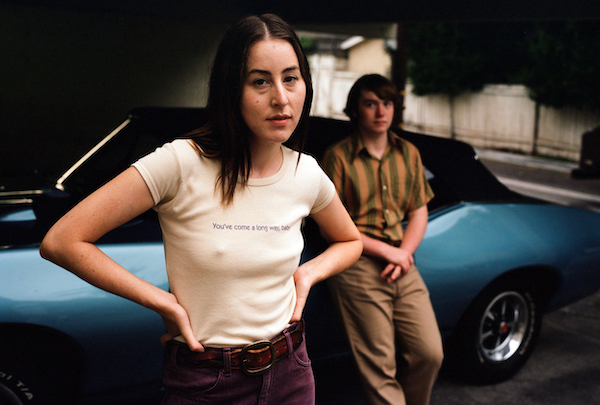Film Review: “Licorice Pizza” — ’70s Bliss
By David Stewart
Licorice Pizza, director Paul Thomas Anderson’s ninth feature film, proves that he is a purveyor of cinematic joy.

Alana Haim and Cooper Hoffman in Licorice Pizza. Photo: MGM
Paul Thomas Anderson has been called many things over his 25-year career as a writer/director: wunderkind, genius, even the Martin Scorsese of Southern California. Forget the dueling superlatives. Licorice Pizza, his ninth feature film set for a 70mm release on Christmas at the Coolidge Corner Theatre, proves that he is a purveyor of cinematic joy. Period.
A native son of the San Fernando Valley, Anderson goes back to his home turf in the ’70s, territory he’s covered before in his platform-shoed, cocaine-fueled sophomore hit of 1997, Boogie Nights. In 2014 he was back with his bong-rattling adaptation of Thomas Pynchon’s Inherent Vice. Licorice Pizza is set in 1973, and Gary Valentine (Cooper Hoffman’s acting debut), a child actor and aspiring entrepreneur, can’t take his eyes off of 25-year-old Alana Kane (Alana Haim, one-third of the all-sister L.A. band, Haim), once he sees the photographer’s assistant walking along the school blacktop (Nina Simone’s “July Tree” is playing on the soundtrack). Alana is as brutally honest as she is radiant: she teases Gary about his age and rebuffs his advances during their chance encounter on “school picture” day. But Gary is not your typical lovelorn teenager, content to admire his desired women from afar. He is determined to win Alana over with his charm and hustler-like ambition to be a success, whether it is selling waterbeds or auditioning for commercials. Did I forget to mention that Gary’s only 15 years old?
Licorice Pizza sets the couple’s sun-soaked adventures against the era’s gas shortage and the draw down of US troops from Vietnam. Against this political backdrop, Alana and Gary’s relationship is played as a kind of romantic pinball machine, the ball jumping from one crazy flipper to another, often propelled by their encounters with the Valley’s eccentric denizens. Sean Penn plays a William Holden-esque actor who, when he isn’t holding court at the Tail o’ the Cock restaurant, is peeling (wildly) around on a motorcycle. Tom Waits is cast as a cigar-chomping caricature of filmmaker Samuel Fuller, and he dominates when he is on-screen, making expert use of his trademark gravelly voice and flair for impromptu performance art. Bradley Cooper plays an exaggerated version of Hollywood producer Jon Peters, who is said to have been one of the inspirations for Warren Beatty’s overwrought lothario in Hal Ashby’s Shampoo. (The latter is one of a number of ’70s films Anderson references.) Cooper’s oversexed character hits on Alana while she’s sitting behind the wheel of a U-Haul. Filmmaker-cum-actor Benny Safdie plays the charismatic congressmen Joel Wachs, a figure who ups the emotional ante in Alana and Gary’s shaky relationship.
Unlike Boogie Nights and Inherent Vice, Licorice Pizza doesn’t take fancy detours, veering off into Altman-styled character arcs or complex subplots. Anderson focuses intently on the complexities of teenage love, confidently drawing on the acting talent (and chemistry) of Hoffman and Haim. Reduce the film’s title to its initials and you get a sense of how the narrative flows along: this is a “visual” LP blissfully moving from one hit track to the next. The music is used masterfully: the scene in which Alana strolls hand and hand with Gary as Paul McCartney and the Wings’ “Let Me Roll It” blares will make your heart beat with delight, in the same way that Shelley Duvall’s version of Nilsson’s “He Needs Me” delivered the pleasurable goods in Punch-Drunk Love.
As in Phantom Thread, Anderson acts as both director and cinematographer (with some footage shot by Michael Bauman). He succeeds in evoking the freewheeling anarchy of early ’70s California, from cherry bombs exploding in the high school bathroom to pot smoking sessions in the baseball dugout (Jonny Greenwood’s sanguine, harp-tinged score chugs along in the background). The film’s stereotypes have spurred some controversy, particularly John Michael Higgins’s portrayal of a feckless Japanese restaurant owner. But Licorice Pizza is set in the pre-PC era of All in the Family, and Anderson is determined to be accurate about the absurdity of the time, in the same way that Boogie Nights depicted the highs and lows of the porn industry.
It wouldn’t be a Paul Thomas Anderson film without references to his friend and fellow quirky cinematic visionary Jonathan Demme. There’s an obvious Melvin and Howard reference — Penn is seen riding a motorcycle at top speed (a similar stunt can be found in The Master). Less obvious is how the experiences of Demme’s production partner Gary Goetzman, a child actor who grew up to become a producer with Tom Hanks’s Playtone Productions, inspired Licorice Pizza. A burlesque dancer served as Goetzman’s parental guardian so the kid could appear on the Ed Sullivan Show; as a teenager, he delivered a waterbed to Jon Peters. Anderson also channels the counterculture friskiness of George Lucas’s American Graffiti.
British film critic Mark Kermode described Inherent Vice as a film to “inhale.” For my money, Licorice Pizza is a film that leaves you asking for more — a feast of cinematic nostalgia.
David Stewart is a professor of Film and Media Studies at Plymouth State University. Along with teaching, he is a documentary researcher and contributing writer for the Film Stage and PleaseKillMe.com. His film credits include Amy Scott’s documentary Hal and Marielle Heller’s The Diary of a Teenage Girl. He lives outside of Boston with his family and beloved Fender acoustic, Nadine.

> (with some footage shot by Michael Bauman)
That misrepresents, I think, how closely they worked *together* on this one. I think it’s more accurately described as a true collaboration.